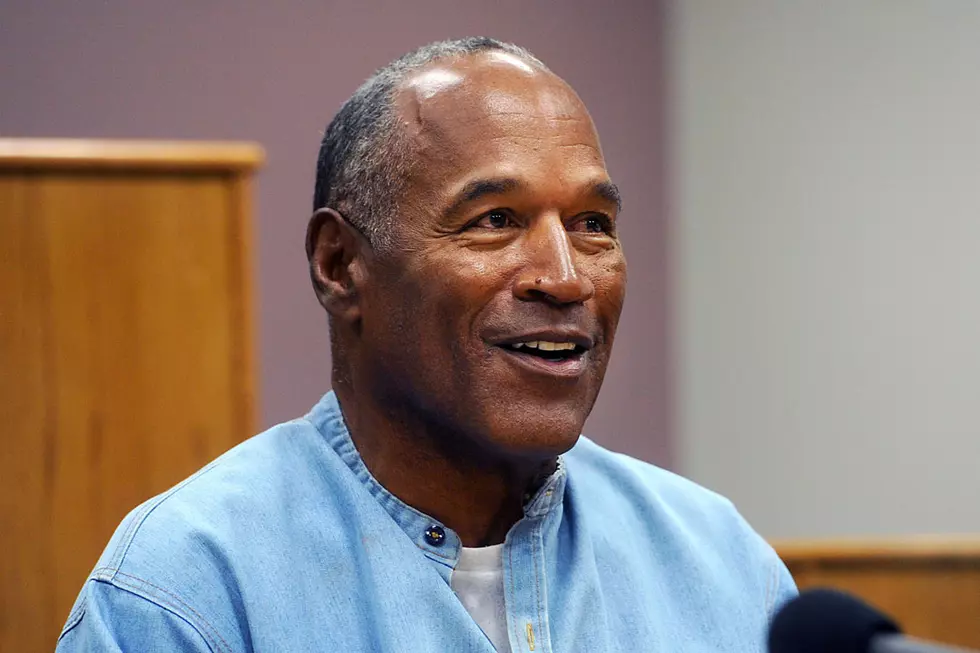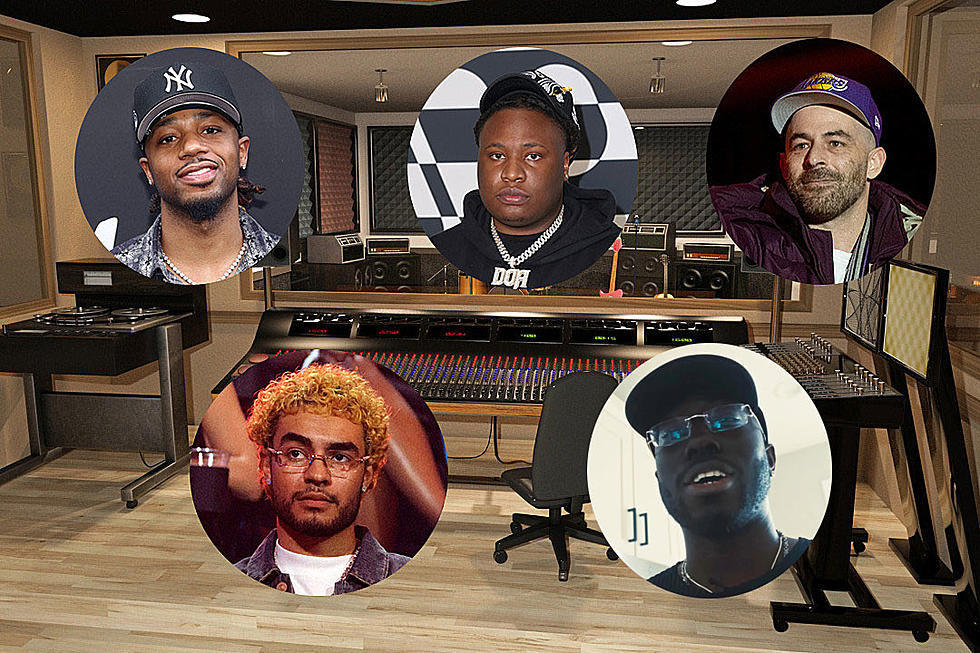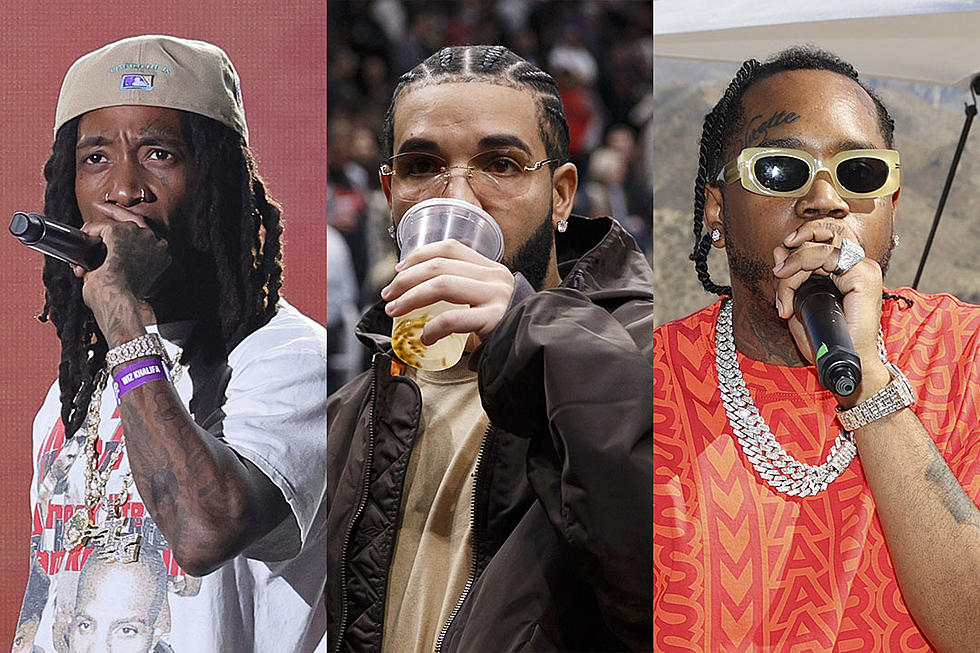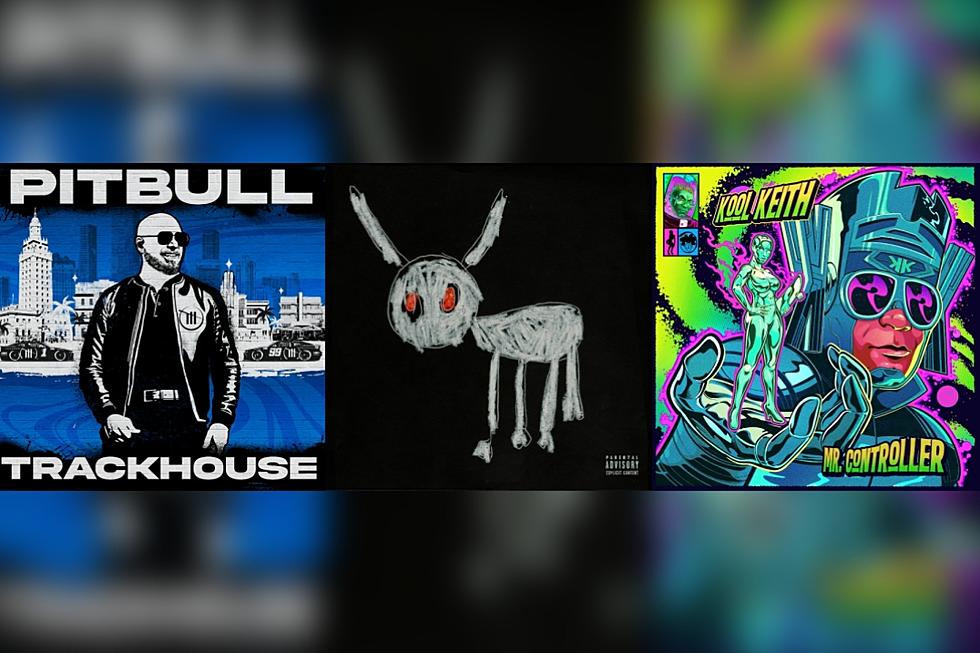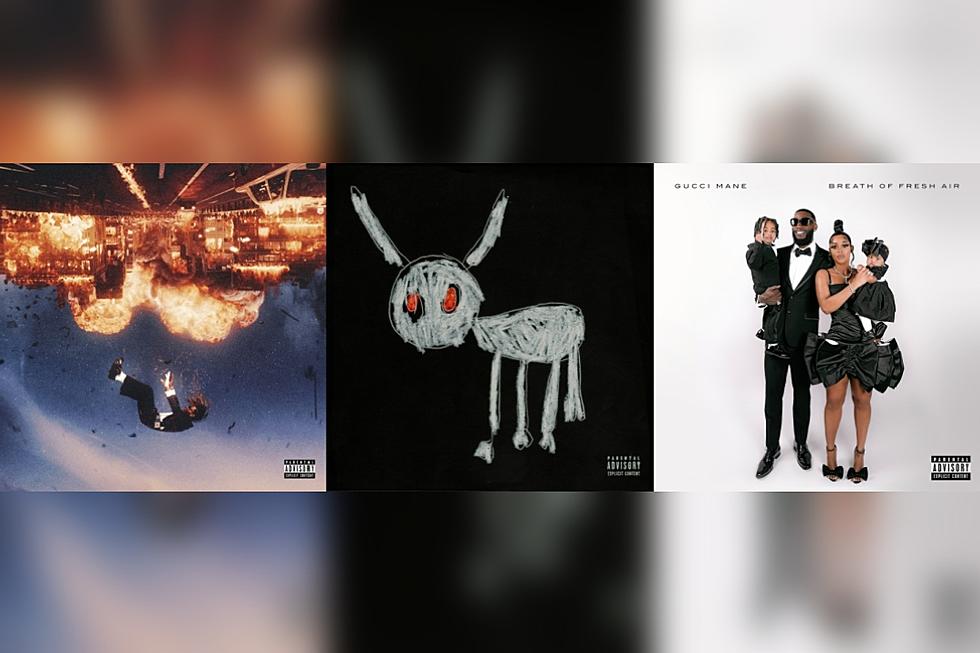![Odd Future: Real Life Fantasy [Excerpt from June 2011 Issue]](http://townsquare.media/site/812/files/2011/06/OddFuture_2.jpg?w=980&q=75)
Odd Future: Real Life Fantasy [Excerpt from June 2011 Issue]
“I hate this part,” says Tyler, the Creator from the darkness. His angular frame is jackknifed into the back storage area of a black SUV. The vehicle crawls through swarms of people milling outside the open-air Mess With Texas concert, part of the South by Southwest music festival held every March in Austin. The 20-year-old rapper and his group, Odd Future Wolf Gang Kill Them All, are scheduled to perform momentarily, and he’s been smacked with a burst of stage fright. “Dude, I’m shaking like a bitch,” he says. He leans forward and growls softly. “Fuckin’ dyke, dyke pussy, dyke pussy, fuck shit,” he says. “Fuck, my face hurts.”
The truck stops. As Tyler and his cohort extract themselves from the cramped vehicle, they’re engulfed in a thicket of boom mics, video cameras and blinding flashbulbs. Someone guides them toward a side entrance, and they stumble through the chaos. From the periphery, people shout “Swag” and “Golf Wang.” The crowd, unseen behind an eight-foot fence, is bellowing one of Odd Future’s catchphrases: “Kill people! Burn shit! Fuck school!”
Tyler’s jitters are dispelled by the time Odd Future hit the stage. Using a laptop, Syd, a lean 18-year-old girl, drops the spare, ominous beat to “Sandwiches,” a track from 2010. During the next 20 minutes, the group unleashes a brand of chaos associated more with punk rock than hip-hop. Tyler, after shedding a green ski mask, climbs 15 feet up the speaker scaffolding, peels off his shoes and plunges into the crowd. Hodgy Beats raps while floating atop the congregation’s arms. Left Brain, Domo Genesis and Mike G cause general mischief. As the Budweiser-fueled audience surges forward, crowd surfers are vomited onto the stage and heaved back into the fray by security. Bottles and cans whistle through the air. Near the end of the set, P. Diddy joins the group onstage for a wild rendition of “Fuck the Police,” a Flocka-esque track off 2010’s BlackenedWhite, an album Hodgy and Left Brain made as a duo called Mellow Hype. Tyler lunges into the audience with a skateboard, opening up a nasty gash on a fan’s head. When the victim is ushered backstage after the show, a crush of journalists, bloggers and photographers rush in to document his blood-splattered face. It’s a moment that encapsulates Odd Future: music, mayhem and media.
Despite the presence of Kanye West, Duran Duran, TV on the Radio and countless other acts, Odd Future were indisputably the story of SXSW. Their seven shows—mostly events hosted by magazines, like Billboard, Fader, Thrasher and Vice—culminated an exceedingly rapid and improbable rise to prominence. Without any major co-signs, hit records, albums in stores or major-label support, the group of young artists from Los Angeles went from obscurity to stardom over the course of several breathtaking months.
It’s easy to see why. Mixing Eminem’s toxic content and baroque rhyming with the Neptunes’ spacey production style, Odd Future present a cornucopia of delicious contradictions. They grew up in households where so-called conscious artists like Talib Kweli and The Roots were the soundtrack, yet they rap about violence, screwing White women and doing cocaine. They listen to Three 6 Mafia, Lil B and Waka Flocka Flame, yet they value dense lyricism and low-fidelity production unsuitable for contemporary clubs or radio. Their artsy integrity seems rooted in rap traditionalism, but when compared with groups from the past, they shrug at compliments and sneer at criticisms. “I really don’t listen to rap from the 1990s,” says Tyler. “I was fuckin’ 3 at the time.”
During the music festival, Odd Future and their management team—headed up by Interscope Records veteran Christian Clancy—turned a split-level ranch in the Austin suburbs into a flophouse. On a warm afternoon, members of the group spend downtime lounging in a backyard Jacuzzi. Dos Equis and marijuana circulate. Hodgy proposes chucking eggs into the crowd at the next show, and conversation veers toward other projectiles. “In the Middle East, they stone bitches for cheating,” says Syd. Domo, submerged in the bubbling water fully clothed, cracks jokes about honor killings. Much has been made of Odd Future’s offensive language, but it’s no different from the giddy prude-baiting that comes with any group of shit-talking, skateboarding teenagers.
Just last summer, they could be found on Fairfax Avenue, skating back and forth between boutiques like Diamond and Supreme. “Tyler was yelling at people in the street, screaming out, ‘I don’t punch niggas—I punch bitches in the face!’ ” says Scott Sasso, owner of Brooklyn clothing company 10 Deep, who met the group when he set up a pop-up L.A. branch last summer. “It was a spectacle. He was playfully annoying the folks on the street, but it was harmless.”
A lanky kid with protruding ears and a gravelly voice, Tyler is a producer and a rapper—Wolf Haley and Ace Creator are two pseudonyms—and is largely responsible for the group’s musical orthodoxy and wanton attitude. His debut album, late 2009’s Bastard, is a collection of spongy synths, vulnerability and songs like “AssMilk,” in which he rhymed, “Fuck rap/I’ll be a landlord so I can rape the tenants’ daughter.”
Tyler has more than 100,000 followers on Twitter who read quirky blurbs about evil vacuum cleaners and gastrointestinal problems. “Every rapper’s Twitter, they post some motivational bullshit, or some wisdom Bible shit, or their new collaboration,” he says. “People don’t know people that be themselves.” In February, Tyler signed a one-album deal to release his sophomore effort, Goblin, on XL Recordings, a British indie label that has put out projects by M.I.A. and Vampire Weekend.
FOR MORE ODD FUTURE, GO TO PAGE 2
Back in 2007, Odd Future consisted of Tyler, Hodgy Beats and Left Brain, with affiliate contribution from rapper Casey Veggies. After recording songs on a computer camera microphone, the fledgling crew performed at school talent shows around Los Angeles and put out The Odd Future Tape Vol. 1 in 2008. Since then, Odd Future have been steadily expanding. Mike G, a soft-spoken military brat who lived in Japan and South Carolina before Los Angeles, dropped Ali under the Odd Future banner in spring 2010. There’s also Domo Genesis, a chubby 20-year-old rapper with a tattoo of the star from Super Mario Bros. on his arm.
His weed-exalting debut album, Rolling Papers, came out in the summer of 2010, predating Wiz Khalifa’s album of the same name. A minor kerfuffle occurred when Khalifa announced his identical title, but peace was quickly restored. Syd, who engineers and DJs for the group, linked up with the group when they began recording in a studio in her parents’ Mid-City guesthouse. Openly lesbian, she’s an interesting foil for accusations that the group’s music is misogynistic or homophobic. “I don’t know who deemed faggot a term to be used derogatorily against gay people,” she says. “I use the word faggot to describe lame people. If you’re a faggot, more power to you. Be a faggot. As judgmental as we seem, we’re so the opposite.”
Other affiliates include producer Matt Martians, who put out two albums as The Jet Age of Tomorrow in 2010, and Frank Ocean, a singer who relocated from New Orleans to Los Angeles. Ocean, who is signed to Def Jam and has written for Justin Bieber and Beyoncé, met Odd Future in early 2009 and released his critically lauded mixtape/album nostalgia, ULTRA in February of this year. The diversity of talent within the collective has proven valuable. “You look in the crowd at a show, and you’ll see hipsters, skaters, rockers, Black kids, sneaker heads,” says Domo. “I think all the different types of music we put out pulls in all different types of people.”
Adding to Odd Future’s mythology is the strange saga of Earl Sweatshirt. Although he recorded most of his work when he was 15 and 16, Earl is described by members of the group as the collective’s “best rapper.” His extraordinary command of syllables and dark, twisting phrases—“As hungry as a cannibal trapped in a van of cantaloupes,” he rhymed on “Pigeons,” from his 2010 album EARL—led Hot 97 jock Peter Rosenberg to compare him to Nas. In spring of 2010, though, Earl suddenly disappeared. Rumors claimed that his mother, upset by her teen son’s music and lifestyle, had cloistered him in boot camp or boarding school, but no one would say exactly where he was. “Free Earl” became a common refrain from the group and its fans.
Then, this April, Complex magazine followed a digital bread-crumb trail that found Earl enrolled at Coral Reef Academy, a school in Samoa for wayward youth. His contact with the outside world has been minimal since he was shipped off. “That’s my fuckin’ brother,”
Mike G says. “I didn’t know [where] he was for 10 months.” The group assumes Earl will be back after he turns 18, meaning he may not resurface until early 2012. He’ll be coming home to a very different world. “He might adapt,” says Tyler. “He might go crazy.”
Indeed, things have changed. When Earl left, Odd Future were an underground rap crew putting free mixtapes up on a Tumblr page. And while it could be argued that their
use of said medium was groundbreaking for a rap group, there have been too many watershed moments since to call them a beneficiary of technology. The video to Earl’s self-titled single—which includes footage of the group guzzling a weird potion, pulling out fingernails and bleeding from their nipples—went viral and now has more than 2.5 million views on YouTube. Odd Future sold out shows in Los Angeles and New York, and in February, an inspired performance by Tyler and Hodgy on Late Night With Jimmy Fallon rocketed the group into national notoriety. Replete with fog and garden gnomes, the live rendition of “Sandwiches” culminated with Tyler leaping on the host’s shoulders and Mos Def screaming “Swag!” into the camera like a proud uncle. The following day, Odd Future trended nationally on Twitter. Since then, Tyler has been shouted out by Kanye West and Rosario Dawson, has met Jay-Z for dinner and has seen the video for his single “Yonkers” rack up 6 million views in a month. “The Rosario Dawson thing was crazy,” says Mike G, who acknowledges that being recognized in the street amazes him. “That kind of makes me jealous, a little.”
In late April, Odd Future signed a deal with RED Distribution, a sales and marketing division of Sony Music that works with independent artists. The group now owns Odd Future Records under RED/Sony distribution and will make all creative and business decisions. “If you’re an artist who is comfortable in their own skin, a traditional deal doesn’t make sense anymore,” says Christian Clancy. “The disconnect between many of the majors and youth is as wide as the one between the rich and poor in this country. Kids are now smarter than what’s being sold to them, and the gatekeepers need a new set of keys.”
Despite their light-speed ascension, Odd Future maintain an endearingly earnest attitude toward the relationship between art and commerce. The group rarely collaborates with anyone outside the camp, though Hodgy recently freestyled a verse for a British artist in exchange for $275. “I bought some ice cream, went to the movies, bought some new underwear,” he says, explaining that he came to SXSW with a single dollar in his pocket. “Not having money keeps us humble. This is the come-up. It’s priceless. You’re supposed to be broke right now.”
**FOR MORE OF THIS STORY, PICK UP XXL'S JUNE 2011 ISSUE, ON STANDS NOW**
More From XXL
